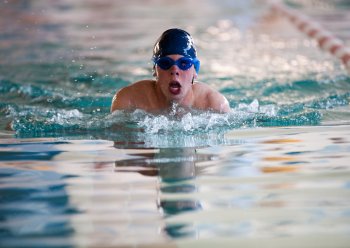Things I am Selling (Jan 2011)
I’ll update with prices once I determine them. Feel free to make offers.
iPad 64GB + 3G with:
- Carbon fibre look case
- Faux leather case
- Hard clear plastic back
- Screen protectors (x2)
- Third party camera kit (USB port and SD card slot in one dongle)
$700 (firm)
Fuji S5 Pro camera body (review) with:
- Nikon MB-D200 battery grip
- Extra battery
What the heck is an S5 Pro, you say? It’s a DSLR released by Fuji featuring their SuperCCD, which is a hexagonal array of sensors with another hexagonal array of smaller sensors squeezed in between. The extra sensors capture highlight information (3 stops) giving this camera a better dynamic range than even the Nikon D3. Also, Fuji’s color processing is so good that you can shoot JPEG and get beautiful skin tones with no effort. My problem with this camera is that the stated resolution of 12MP is basically wrong. There are 12M sensors, but 6M are “normal” and 6M are for the highlight information. Also, since it’s a hexagonal sensor, your raw processing software ends up having to interpolate a rectilinear image, so sharpness isn’t bang on. If you are a sports shooter, the camera will do 3fps max, so don’t get it. If you are starting out with DSLRs, it will make you think you’re a great photographer. 🙂 I’m including the tethering software.
Nikon D300 (review).
Nikon D700 (review).
Color Temperature Testing
I was recently able to use a color temperature meter to test out a few flash units, thanks to the good folks at LightRein.
It wasn’t a very scientific test, but I wanted to get some idea of the difference in color temperature between different shooting conditions.
I tested the following devices:
- Nikon SB-800 (now discontinued, sadly)
- Nikon SB-900
- AlienBees ABR800
- Dyna-Lite 2040 (powered by Dyna-Lite M1000x)
I initially wanted to do the test because I purchased an ABR800 despite reviews citing cheap build quality and wild color temperature variation. The build quality seems good enough for someone who isn’t risking a $50,000 on broken equipment. It’s true that the ABR800 itself is tough plastic, but its reflector accessories, including the Moon Unit, feel pretty janky. My impression after several months of use is that the parts are “sturdy enough” and that Paul C. Buff cut corners where it was the right idea to do so. It may feel like it’s going to break, but I now doubt I’ll break it.
I should also note that my experience with their customer service was very positive. The reflector of my Moon Unit arrived damaged (the reflective surfaces were uneven), and the 20° grid had a very minor manufacturing problem. Their service rep was friendly, answered quickly, and sent me replacements right away. If you need your equipment to feel indestructible and withstand 12 foot drops, you can probably afford to buy a $2000 ring flash and its $3500 power pack. The ABR800 with a ton of useful accessories will set you back a mere $585.01, and if you’re moving up from battery powered flash units, you won’t be sorry.
Build quality aside, I wanted to do some testing to put some real numbers on the complaints I’ve heard regarding color temperature variance. I’ll start with the SB-800 and SB-900.
The keys in the charts below are hard to read, so here is the raw data, including charts, posted to Google Docs.
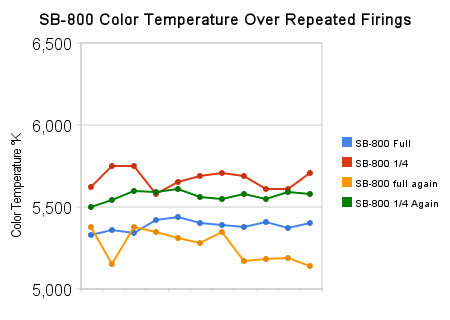
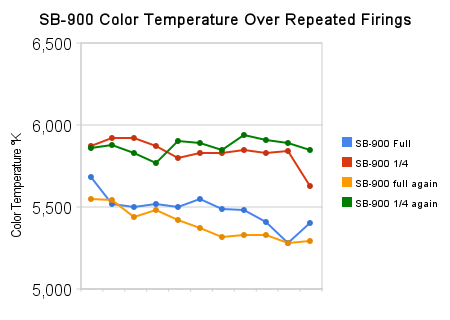
I was surprised at how much the SB-800 and SB-900 jumped around. With more time, I would have done a lot more test firings to get a better idea of the variance. This is a relatively informal test. Still, a few things seem clear: the SB-900 and SB-800 perform differently. You’re going to get a colder pop out of the SB-900 than you’d probably want if you aren’t firing at full power. The SB-800 seems more centered around 5500 °K. The SB-800 can be had, used, for about $420 CAD. I saw them go for $450 CAD new at one point. The SB-900 is $550 CAD.
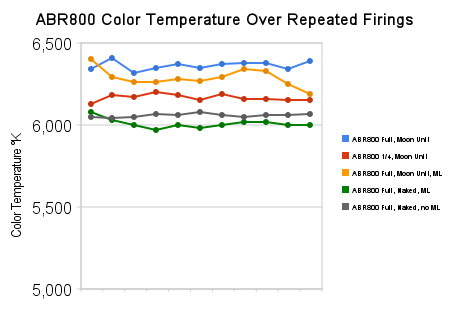
The ABR800 on its own will set you back $400. You don’t get fancy optical remote control power like you do with a Nikon flash, but the color consistency is better than on the SB-800 and SB-900, and you get a lot more power. Still, this thing plugs into the wall, so if you want to go outside with it, you’re looking at a few more hundred bucks on something like a Vagabond II.
I tested the ABR800 with the “Moon Unit” softbox attachment, and also with the modeling lamps on and off. The reason for the latter test is that I’d heard that the modeling lamps caused color temperature variation problems. I left the lamps on for a long time before and during the tests labeled “ML”. It didn’t seem to make a significant difference.
Sadly, the ABR800 is much cooler than the other units I tested. This could be a problem if you’re using it with other lights. The AlienBees website says to expect the color temperature to be around 5500 °K, so I’ve sent an email asking if my results were normal. I’ll update this page when I’ve heard back.
Still, I’m convinced it’s worth the money I paid.
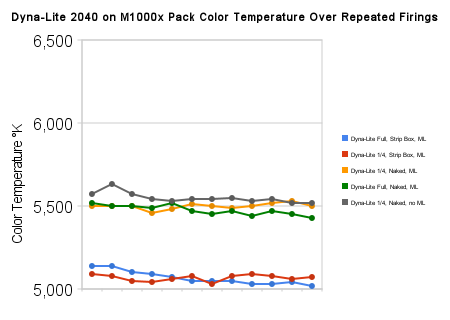
If you’re willing to spend thousands of dollars on new Dyna-Lite equipment, you will of course not be disappointed. My own Dyna-Lite strobes were relatively cheap because I got them used. Pro equipment tends to last forever.
I was not surprised to see that between a 1000W/s blast (I felt like I was tanning a bit) and a 250W/s pop, the color temperature basically kept close to 5500°K. I was surprised that my 1’x6′ strip box made that much of a difference in the warmth.
Take these results with a grain of salt: the room I was in has burgundy walls. Each light was fired from a different position in the room. The time between flashes was not consistent. The batteries in the SB-800 were starting to die, whereas the batteries in the SB-900 were fresh. This was not a rigorously scientific test by any means. At best, it provides some hints.
At some point, personal preference has to take center stage. This sort of obsessive measurement, done well, might be more meaningful to someone doing fine art reproduction. Still: if you’re using an ABR800 for fill and an SB-800 at full power as your main light, maybe you should convert your image to black and white. 😉
Help-Portrait 2009
I learned about Help-Portrait through a coworker. It is a North America-wide event where people including photographers, editors, and makeup artists get together to provide professional portraits to anyone for free. I was skeptical at first, but photographer and founder Jeremy Cowart’s intro video made it clear that a professional portrait session really makes people feel special.
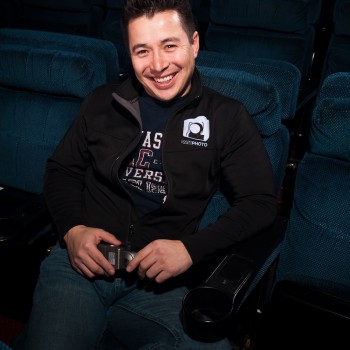 Javier Salazar (pictured) and Lillian Patz organized the Edmonton Help-Portrait event, which happens everywhere in North America in multiple locations per city. You may remember December 12th as having been Edmonton’s record-breaking coldest day, and that definitely had an impact on how many people showed up to do a portrait.
Javier Salazar (pictured) and Lillian Patz organized the Edmonton Help-Portrait event, which happens everywhere in North America in multiple locations per city. You may remember December 12th as having been Edmonton’s record-breaking coldest day, and that definitely had an impact on how many people showed up to do a portrait.
In between clients, I snapped a few portraits of some of the great volunteers who came to help the photographers and hand out food and drinks to our clients, as well as the other photographer with whom I was swapping customers, Steve Osborne. There was even an outbreak of Edmonton’s Next Top Model fever.
I’m really looking forward to doing this again next year. It’s a great event, and if you’d like to sponsor it, please let me know.
Bill Kelliher
Last night I got an opportunity to take part in the next The Force in the Flesh book, an ongoing project by Tattoo and Star Wars buff, Shane Turgeon.
Bill Kelliher of Mastodon was scheduled to do a shoot with Curtis Comeau, but it was not to be.
I was called in to do an emergency shoot before Mastodon hit the stage at Shaw Conference Centre. The best we could do for a location was the corridor by the dressing rooms immediately behind the stage. As the corridor is open to the actual hall where the concert was going on, communication was limited to yelling directly into ears. 🙂
For the portrait, I used my Dyna-Lite strobes in gridded, diffuser-less Lightrein softboxes for rim lighting, all shot with my Nikkor 24-70mm f/2.8 on the D700 through an Alienbees ABR800, which I’ll be reviewing soon…
The shots worked out pretty well, though I felt like I could have spent a bit more time. I tried to keep the lighting on the tattoos consistent with what Shane showed me in the first Force in the Flesh book.
I’ll sign off with a photo of Bill and Shane looking approximately 1000 times more badass than I ever will (each) and a lighting test shot with Shane.
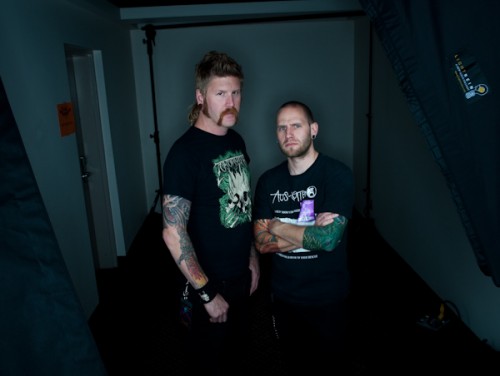
Bill Kelliher of Mastodon with Shane Turgeon
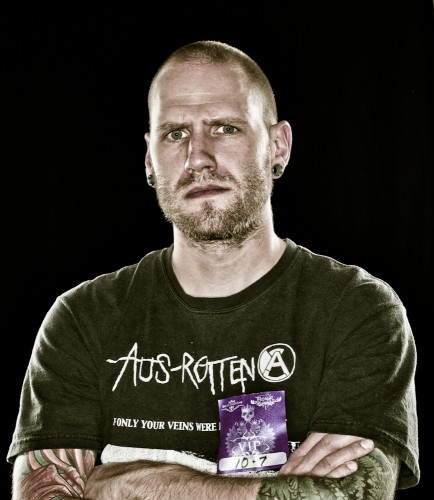
Shane Turgeon Lighting Test
CJSR FunDrive
Kind thanks to Mike, Christine, Maya, Heather, Desiree, Colin, David, Jocelyn who assisted and modeled for the CJSR FunDrive 2009 photos.

Things change during a shoot: my sunny original concept was thrown out the window by the following:
- Location (Quad at the U of A) was full of tables and chairs
- Due to junk in the way, our location lost sun before we could start
- Time-critical shots of opportunity pushed the time further back
- Rain, wind, thunder, lightning
Can you believe how chicken my subjects were about being near tall metal stands in a lightning storm? Some people! 🙂
At any rate, the guerilla shoot went great, and a good time was had by all.
Special Olympics
I shot the Alberta Special Olympics this weekend. I was happy with the shots I got, and will post some when I have authorization.
You hear about how individuals with mental disabilities are inspiring, but it never clicks until you see an event like this. Watching these athletes put in that kind of work definitely makes you feel bad for any time you’ve ever put in less than 100% effort.
All the athletes I spoke to were extremely pleasant, and they had a great time.
One of my photos is now on the Special Olympics Alberta website:
